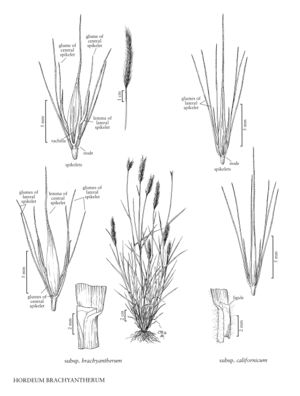Difference between revisions of "Hordeum brachyantherum subsp. brachyantherum"
FNA>Volume Importer |
imported>Volume Importer |
||
| (8 intermediate revisions by 2 users not shown) | |||
| Line 1: | Line 1: | ||
{{Treatment/ID | {{Treatment/ID | ||
|accepted_name=Hordeum brachyantherum subsp. brachyantherum | |accepted_name=Hordeum brachyantherum subsp. brachyantherum | ||
| − | |accepted_authority= | + | |accepted_authority= |
|publications= | |publications= | ||
|common_names=Meadow barley;Northern barley;Orge a antheres courtes;Orge des pres | |common_names=Meadow barley;Northern barley;Orge a antheres courtes;Orge des pres | ||
| Line 16: | Line 16: | ||
-->{{Treatment/Body | -->{{Treatment/Body | ||
| − | |discussion=<p>Hordeum brachy anther um subsp. brachyantherum grows in pastures and along streams and lake shores, from sea level to 4000 m. Its range extends from Kamchatka through western North America to Baja California, Mexico. It is also known from disjunct locations in Newfoundland and Labrador and the eastern United Sates. The latter are probably recent introductions; the Newfoundland populations are harder to explain. One population from California is known to be hexaploid.</p> | + | |discussion=<p><i>Hordeum</i> brachy anther um <i></i>subsp.<i> brachyantherum</i> grows in pastures and along streams and lake shores, from sea level to 4000 m. Its range extends from Kamchatka through western North America to Baja California, Mexico. It is also known from disjunct locations in Newfoundland and Labrador and the eastern United Sates. The latter are probably recent introductions; the Newfoundland populations are harder to explain. One population from California is known to be hexaploid.</p> |
|tables= | |tables= | ||
|references= | |references= | ||
| Line 25: | Line 25: | ||
-->{{#Taxon: | -->{{#Taxon: | ||
name=Hordeum brachyantherum subsp. brachyantherum | name=Hordeum brachyantherum subsp. brachyantherum | ||
| − | + | |authority= | |
| − | |authority= | ||
|rank=subspecies | |rank=subspecies | ||
|parent rank=species | |parent rank=species | ||
| Line 32: | Line 31: | ||
|basionyms= | |basionyms= | ||
|family=Poaceae | |family=Poaceae | ||
| + | |illustrator=Cindy Roché;Annaliese Miller | ||
| + | |illustration copyright=Utah State University | ||
|reference=None | |reference=None | ||
|publication title= | |publication title= | ||
|publication year= | |publication year= | ||
|special status= | |special status= | ||
| − | |source xml=https:// | + | |source xml=https://bitbucket.org/aafc-mbb/fna-data-curation/src/200273ad09963decb8fc72550212de541d86569d/coarse_grained_fna_xml/V24/V24_346.xml |
|subfamily=Poaceae subfam. Pooideae | |subfamily=Poaceae subfam. Pooideae | ||
|tribe=Poaceae tribe Triticeae | |tribe=Poaceae tribe Triticeae | ||
Latest revision as of 16:23, 11 May 2021
Plants densely cespitose. Culms 30-95 cm, often robust, sometimes slender. Basal sheaths usually glabrous, sometimes sparsely pubescent; blades to 19 cm long, to 8 mm wide, both sides usually glabrous, sometimes with hairs to 0.5 mm on both surfaces. Glumes 7-17 mm, usually straight at maturity; lemmas usually awned, awns to 6.5 mm, usually straight at maturity; anthers 0.8-3.5 mm. 2n = 28, 42.
Discussion
Hordeum brachy anther um subsp. brachyantherum grows in pastures and along streams and lake shores, from sea level to 4000 m. Its range extends from Kamchatka through western North America to Baja California, Mexico. It is also known from disjunct locations in Newfoundland and Labrador and the eastern United Sates. The latter are probably recent introductions; the Newfoundland populations are harder to explain. One population from California is known to be hexaploid.
Selected References
None.
